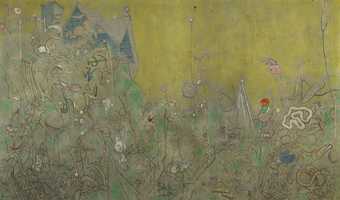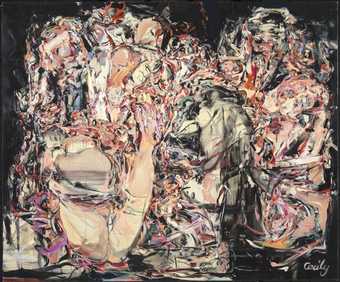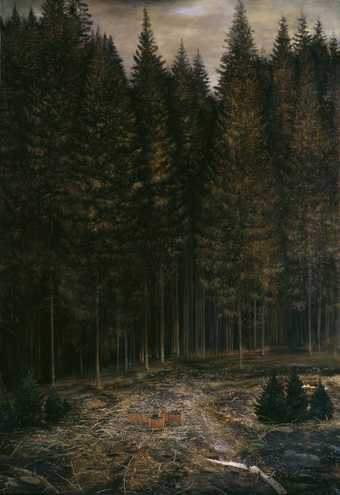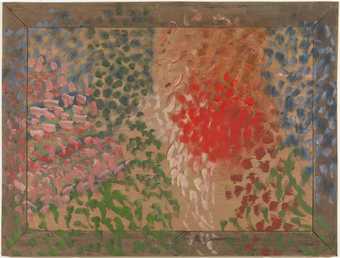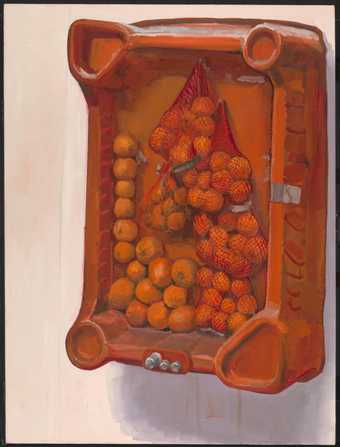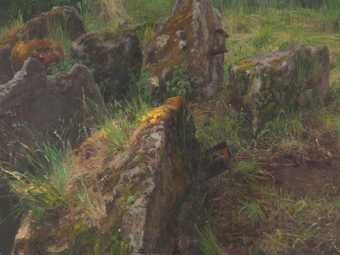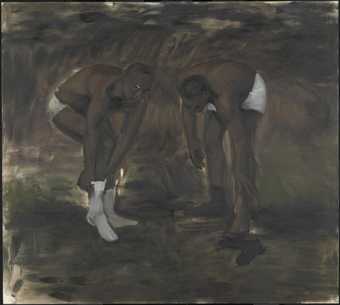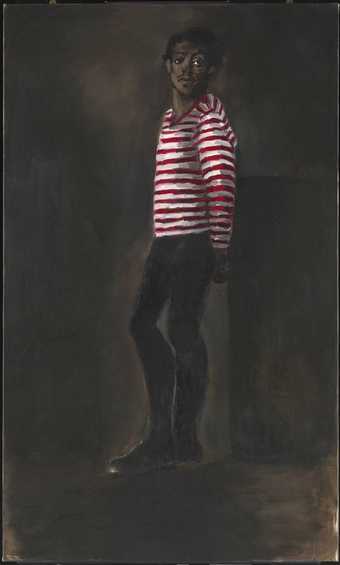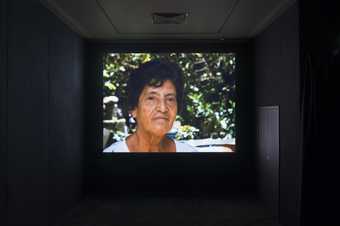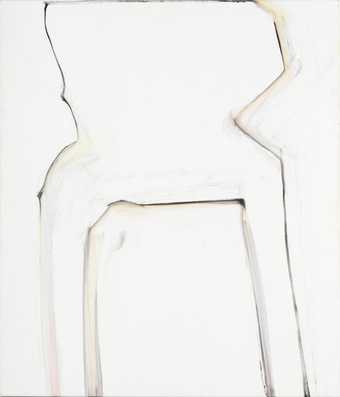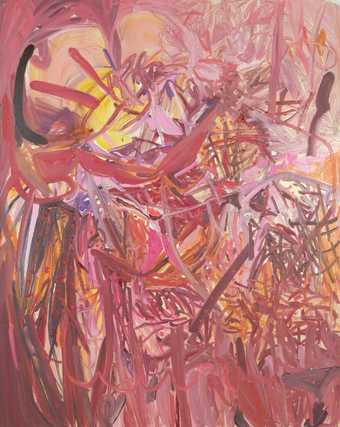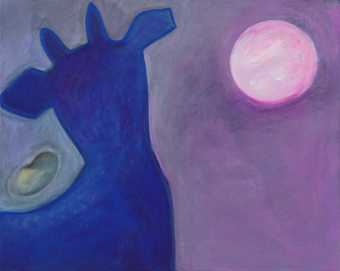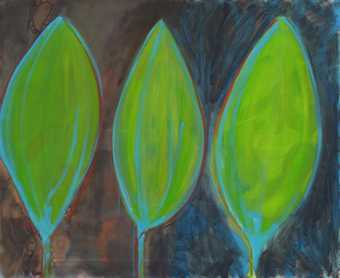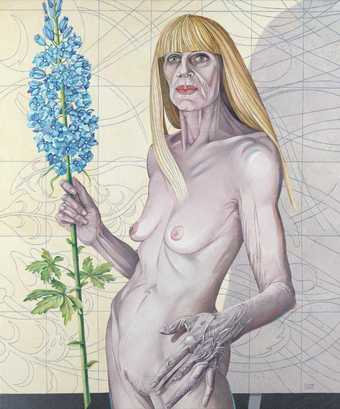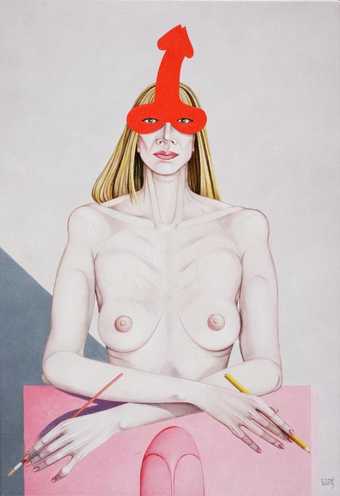
Not on display
- Artist
- Rosalind Nashashibi born 1973
- Medium
- Oil paint on canvas
- Dimensions
- Support: 604 × 904 mm
- Collection
- Tate
- Acquisition
- Presented by Tate Patrons 2018
- Reference
- T15036
Summary
In Vivian’s Garden is an abstract landscape painting made in 2016 in direct response to the process and environment which Nashashibi experienced during the making of her film Vivian’s Garden 2017 in Guatemala. The film is also in Tate’s collection (Tate T15055); over thirty minutes, it depicts the relationship between two Swiss /Austrian émigré artists who are mother and daughter – Elisabeth Wild (born 1922) and Vivian Suter (born 1949) – in the connected houses they share in a jungle garden in Panajachel, Guatemala, where they have developed a matriarchal compound in an environment that is both idyllic and somewhat threatening. The painting consists of two violet, ovoid forms that fill the right-hand side of the canvas and sit atop a lime-green wash of swirled paint on a black ground. From the lower of the two violet shapes extends a thin tube or tendril which, as it reaches to the far left of the canvas, feels almost plant-like or biological in the way that it twists and contorts. At the very bottom of the canvas, the whole of the lower section of its composition is reflected or mirrored, as though the entire canvas is sitting on water or some other reflective surface. Although completely abstract in its composition, the painting resonates strikingly with the content and atmosphere of the Vivian’s Garden film. Its watery tones and the slight translucency of all its forms, combined with the swirling waves of paint and the natural colour palette, evoke the feeling of a jungle or dense garden at various times of the day, from dusk until nightfall. In doing so, the painting presents a different – but interconnected – depiction of Nashashibi’s time in Guatemala, as she has explained:
Painting is a very direct way of moving forward with my thinking. It takes place privately and happens when I want it to, where I am, where forms and colours and visual ideas relate to and change one another under my hand – what I am talking about is a constant development, without much pre-planning, much like my filmmaking but unlike it in that aspect of instantaneous progression. That is true whether painting from a sketch or without any pre-established direction. Often a visual structure may be formed in my mind from a passage in a novel … or from a photograph … or from a drawing of mine such as In Vivian’s Garden. Equally another painting might be a starting point, Matisse’s Tea in the Garden is the guide of a painting I am working on now, and my daughter’s paintings have influenced other works.
(Rosalind Nashashibi in email correspondence with Tate curator Laura Smith, 5 June 2017.)
Nashashibi returned to painting after an encounter with the Swiss artist Renée Levi (born 1960) with whom she exhibited in a two-woman show at the Galerie Marcelle Alix in Paris in 2013. Levi had made a series of very large abstract paintings consisting of brown ovoid forms, like stones, positioned scatologically. Following a conversation between the two artists, it transpired that Levi had made the paintings in direct response to Nashashibi’s film for the exhibition, a video called Carlo’s Vision 2011. For Nashashibi, Levi’s response suggested another way of looking at filmic and painterly production that was unexpected, and encouraged her to see that she could also make abstract paintings from thinking about films. She has described her endeavour as making abstract, gestural works that are nevertheless concrete replies to a proposition or narrative:
Levi made painting seem possible, as abstraction could come from anywhere just like my films, it could come from being moved by something completely different from itself, something that isn’t completely understood – or doesn’t need to be articulated, other than in the painted response. This is what I have also loved about filming situations without planning first … I hope that it’s clear from my films that I am using the medium to take a closer look, to find a way to present and so reveal to myself the forces and rhythms that combine to form an experience that I have had. That is something that an initial look at footage just back from the lab cannot capture: the layers of reality that we are aware of when fully present in an encounter and not looking through a camera, the layers of responses our body, emotions and memory make to a moment in time, place and a social action. So with films I want to present what recently happened in its multiple realities, some of which are visible and others that are not simply visible, or directly showable. The aim in the films and the paintings is to come across the immanence in forms, things, in transactions and in between them, something that comes through allowing experience of the present time and conditions to permeate through my looking.
(Ibid.)
Further reading
Francis McKee, Rosalind Nashashibi, Fruitmarket Gallery, Edinburgh 2003.
Herbert Martin and Rosalind Nashashibi, Rosalind Nashashibi, Institute of Contemporary Arts, London 2009.
Quinn Latimer and Adam Szymczyk, Documenta Daybook, Munich 2017.
Laura Smith
November 2017
Does this text contain inaccurate information or language that you feel we should improve or change? We would like to hear from you.
You might like
-
Nigel Cooke Artist’s Garden
2006 -
Cecily Brown Trouble in Paradise
1999 -
Ged Quinn Cross in the Wilderness
2003–4 -
Howard Hodgkin Come into the Garden, Maud
2000–3 -
Simon Ling Untitled
2008 -
Simon Ling Untitled
2010 -
Lynette Yiadom-Boakye The Generosity
2010 -
Lynette Yiadom-Boakye 10pm Saturday
2012 -
Rosalind Nashashibi Vivian’s Garden
2017 -
Rosalind Nashashibi At My Post
2016 -
Jadé Fadojutimi I Present Your Royal Highness
2018 -
Rosalind Nashashibi Indifference
2017 -
Rosalind Nashashibi Untitled
2018 -
Caroline Coon Self with Delphinium Age 70
2016 -
Caroline Coon Self in Cock Mask
2003

